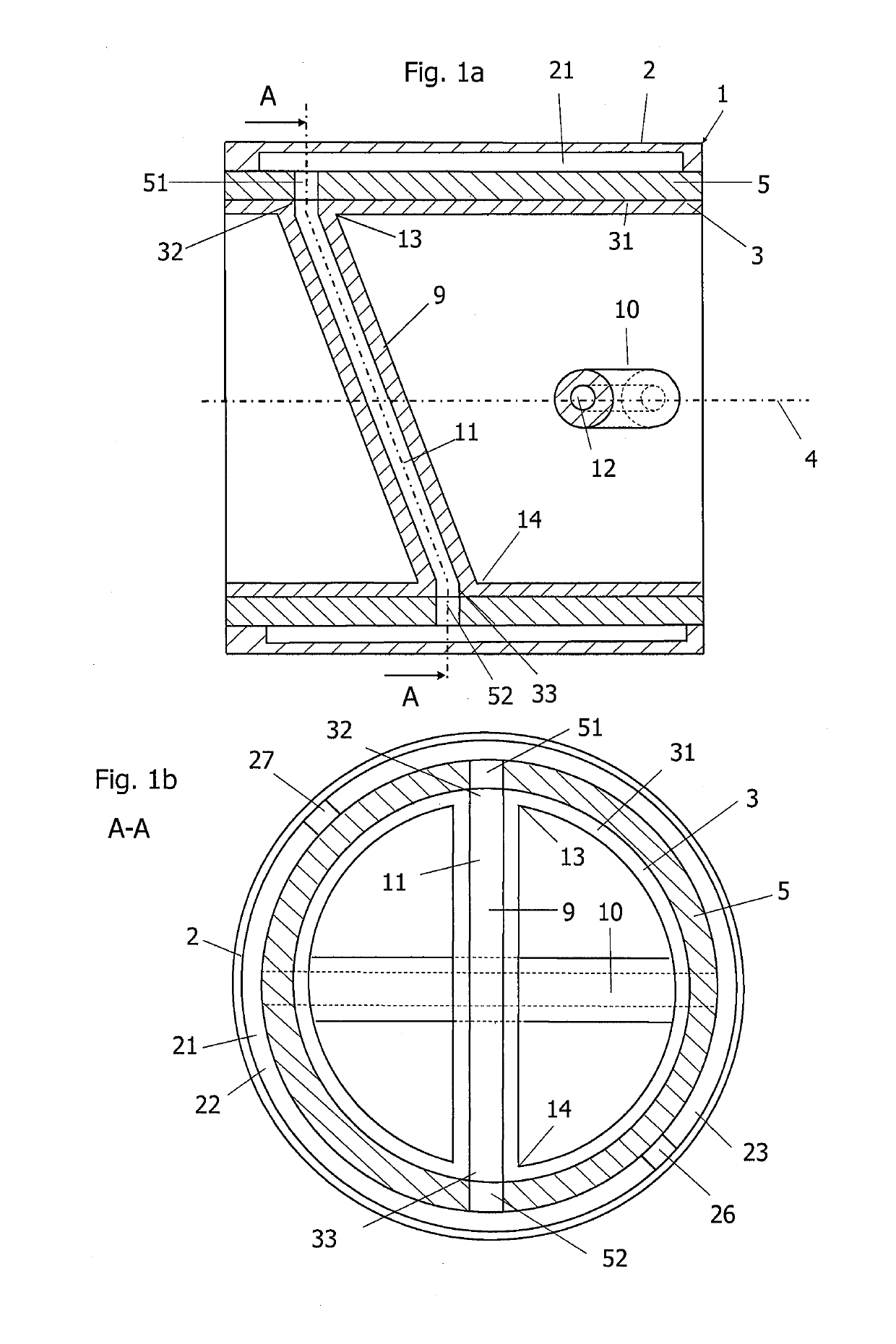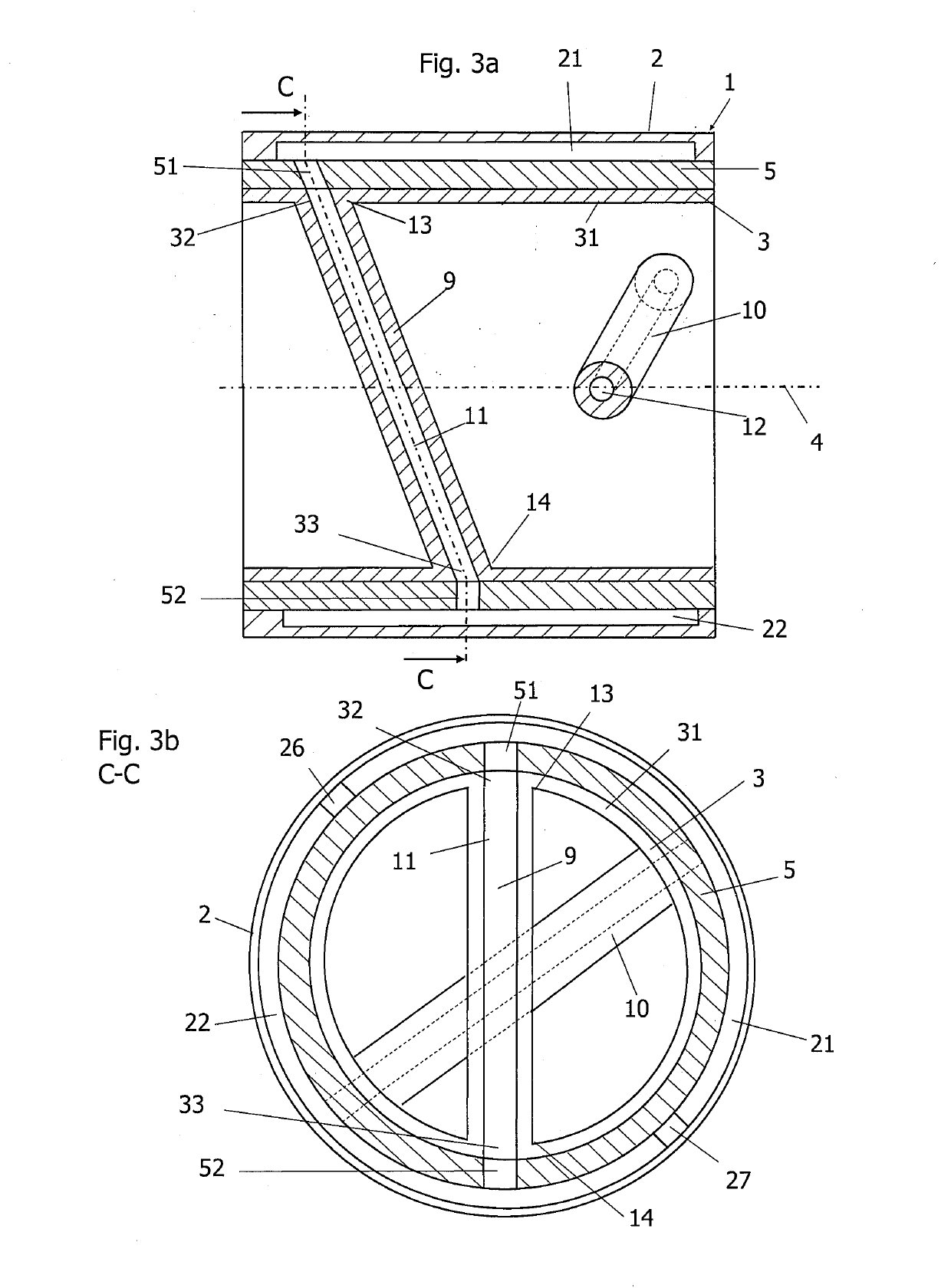Heat Exchanger
a heat exchanger and heat exchange surface technology, applied in indirect heat exchangers, lighting and heating apparatus, transportation and packaging, etc., can solve the problems of requiring a relatively large amount of space, unable to obtain homogenous mixtures with such heat exchangers and static mixers, and achieving high thermal conductivity, high resistance to chemicals, and high quality.
- Summary
- Abstract
- Description
- Claims
- Application Information
AI Technical Summary
Benefits of technology
Problems solved by technology
Method used
Image
Examples
first embodiment
[0066]FIG. 1a shows a longitudinal section through a heat exchanger according to a The heat exchanger 1 for static mixing and heat exchange according to FIG. 1a contains a jacket element 2 and an insert element 3, the insert element 3 being arranged in the interior of the jacket element 2 in the operating state. The jacket element 2 is designed as a hollow body. The insert element is received in the hollow body. The insert element 3 has a longitudinal axis 4, which extends essentially in the main flow direction of the flowable medium, which flows through the jacket element 2 in the operating state. The insert element 3 contains an insert jacket element 31 and at least one web element 9, 10. The web element 9, 10 has a first end 13 and a second end 14, the first end 13 and the second end 14 of the web element 9, 10 is connected to the insert jacket element 31 at different locations. The web element 9, 10 contains a web element channel 11, 12. The web element channel 11, 12 extends f...
second embodiment
[0072]FIG. 2a shows a longitudinal section through a heat exchanger 1 according to a The heat exchanger 1 comprises an insert element 3, an intermediate jacket element 5 and a jacket element 2. The insert element 3 comprises a first and second group 6, 7 of web elements 9, 10 fixed to a non-zero angle with respect to the main flow direction and fixedly connected to at least a part of web elements 9, 10 connected insert jacket element 31. The web elements 9, 10 include web element channels 11, 12. These web element channels 11, 12 are flowed through in the operating state by a heat transfer fluid. The heat transfer fluid is not in communication with the flowable medium, which flows around the web elements 9, 10, FIG. 2a shows a first insert element 3 and a second insert element 3, which have the same structure. For each of the first and second insert elements 3, an intermediate jacket element 5 and a jacket element 2 can each be provided. Alternatively, each of the first and second ...
fourth embodiment
[0093]FIG. 4a shows a longitudinal section through a heat exchanger 1 according to a The web elements 9, 10 of the insert element 3 are arranged substantially in the radial direction, that is, the longitudinal axis of the web elements 9, 10 extends at an angle of 90 degrees to the longitudinal axis 4. The web elements 9, 10 may have a circular or oval cross-section.
PUM
| Property | Measurement | Unit |
|---|---|---|
| thicknesses | aaaaa | aaaaa |
| temperatures | aaaaa | aaaaa |
| pressures | aaaaa | aaaaa |
Abstract
Description
Claims
Application Information
 Login to View More
Login to View More - R&D
- Intellectual Property
- Life Sciences
- Materials
- Tech Scout
- Unparalleled Data Quality
- Higher Quality Content
- 60% Fewer Hallucinations
Browse by: Latest US Patents, China's latest patents, Technical Efficacy Thesaurus, Application Domain, Technology Topic, Popular Technical Reports.
© 2025 PatSnap. All rights reserved.Legal|Privacy policy|Modern Slavery Act Transparency Statement|Sitemap|About US| Contact US: help@patsnap.com



